All they wanted was a chance for ten more days of football.
Just before the end of the season, a quarter of the players and one of the coaches on the Xavier High School Knights had been forced from their homes when Superstorm Sandy slammed into the East Coast. But when the displaced kids voted to play on, their courage inspired the team to go on to an improbable playoff rumble and the Catholic High School Football League AA crown, an amazing championship run that cheered a reeling city, landed the team on ESPN Sports Center and Good Day New York and turned them into the feel-good story of Hurricane Sandy.
There was no sign of impending doom on the last day of the regular season, even though news reports had been warning of the approaching monster storm. With time running down at the end of the first half, Xavier wingback and special teams member Ryan McDade grabbed the football on the 12-yard line against Christ the King and dashed 88 yards for a touchdown.
The jaunt by the wiry 5 ft 8 in, 150 lb senior meant that momentum, which seemed to be tilting toward CTK seconds earlier after they had returned a kickoff for a touchdown to move within one score, shifted instantly back to Xavier. The Knights went into halftime with a 20 to 7 lead and would go on to win decisively.
The win meant Xavier ended the regular season with a 6 and 2 record and a 5 and 2 record in the league, which put them in third place and made them a decided long shot to win the playoffs in the Catholic High School Football League AA division, which stretches across Long Island, New York City, and Westchester.
For someone on the special team, running a kickoff back for a TD in the final regular-season game of your senior year might go down as the highlight of the year.
Two days later, on October 29, 2012, the rains came. And then the fire.
For McDade and many of his teammates, their lives were turned upside down.
The school, in the Chelsea section of Manhattan just north of Greenwich Village, was founded by the Jesuits in 1847, but a good number of its students have always come from the outer boroughs of New York. Over the past few decades, a growing number have come from Breezy Point, the so-called Irish Riviera, and other neighborhoods up and down the Rockaway Peninsula. Xavier is a private school, but one where the sons of cops and firemen and nurses can still scrimp and save to send their boys for a tough, old-school academic regimen. Forty percent of its students join the Junior Reserve Officers Training Corps. One of the alums, Antonin Scalia, sits on the U.S. Supreme Court.
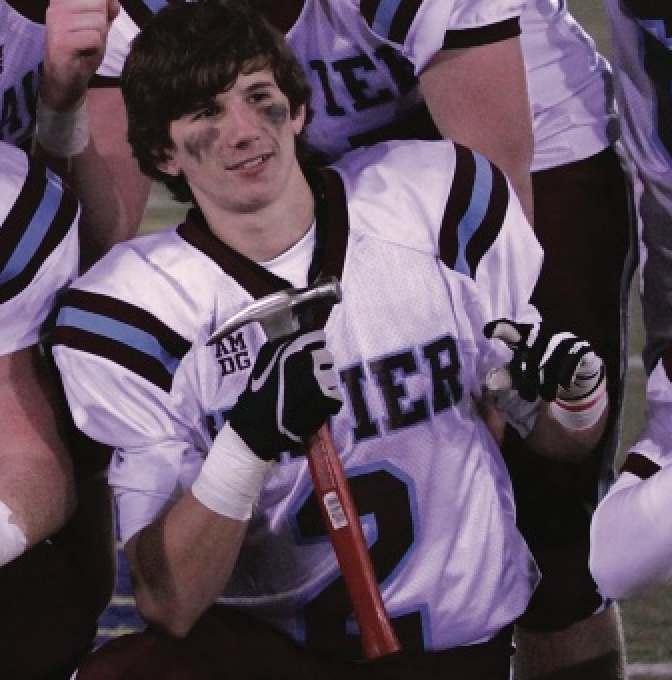
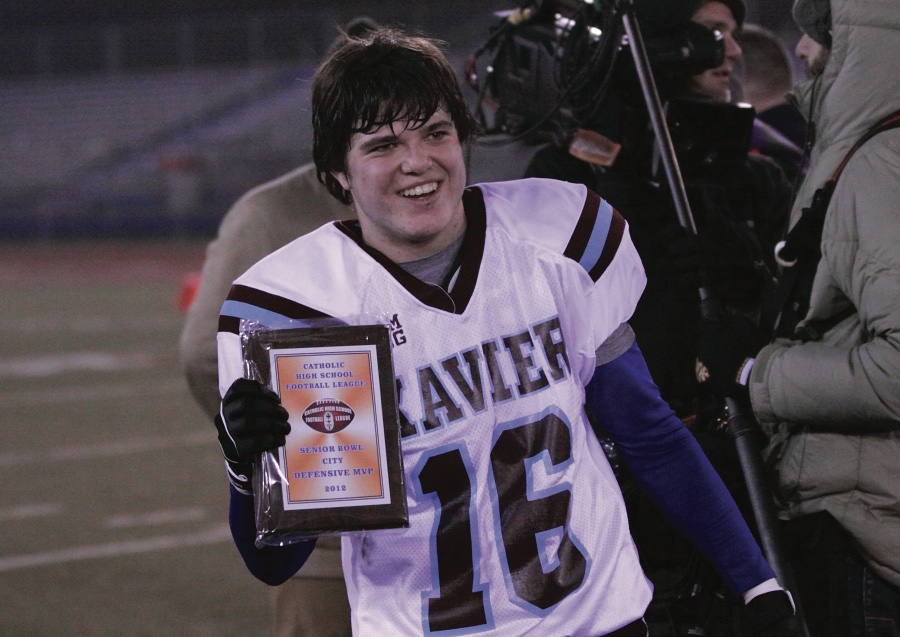
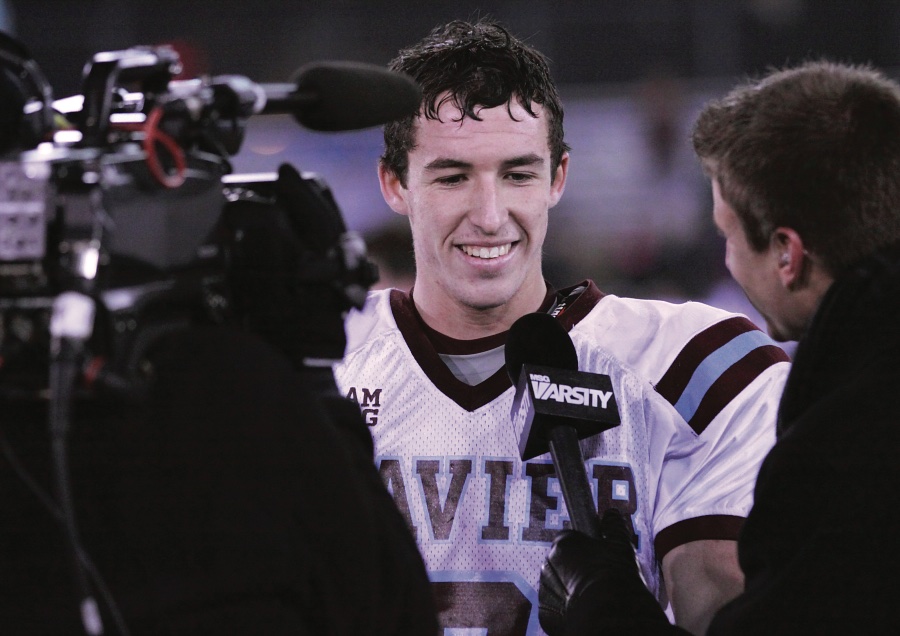
The Xavier Knights have had good football seasons, but the last time they went all the way in the playoffs to a varsity championship was 16 years ago. Their brand of football is ground and pound with a conservative offense known as the Princeton single wing. “We don’t throw the ball a lot, but we were the leading rushing team in the city,” said Coach Chris Stevens, with over 3,600 yards on the ground.
On Oct. 29. as Superstorm Sandy blew ashore in Breezy, the furious Atlantic raged over the narrow peninsula and met up with the Rockaway Inlet and Jamaica Bay. Rockaway Peninsula was underwater.
Ryan Kilgallen, a senior running back and one of the co-captains, recalled piling sandbags outside his home that Monday evening in a futile attempt to keep the floodwaters from his bedroom in the basement of his Belle Harbor home. Jimmy Wolfer, the team’s defensive MVP, recalls watching the raging sea from his apartment building in Rockaway. “The boardwalk ended up snapping and hitting the lobby of the apartment building,” he recalled. “Water was hitting the apartments on the second floor.”
In Manhattan, team co-captain and tight end Connor Sweet was at his apartment on the East Side when all of lower Manhattan suddenly went dark a little after 8:30 p.m. Floodwaters had cascaded into a Con Edison power plant on the East River and 15 feet of water had filled the lower level. After some crackles and pops, the plant sent off an electric blue bolt that gave a brief brilliant flash of illumination across the night sky. And then every neighborhood from the 30th Street area to the Battery plunged into darkness that would last five days or longer.
Things were going far worse in the Rockaways and Breezy, where flooding started around 6 p.m., a few hours before the expected high tide around 8:30 p.m.
Just before 7:30 p.m., the first reports of a fire in Breezy came in. Fire engines from the Breezy Point Volunteer Fire Department were stranded. Their Zodiac fireboats floated off the trailers and were pushed out to the flooded Rockaway Beach Boulevard. It would be five to six hours before FDNY fire trucks could get their rigs through the water to try to quench the flames. The fire, unchecked and whipped by winds gusting up to 80 MPH, was leaping quickly from home to home among the wooden frame houses packed tightly together in the gated Breezy community.
Kilgallen reached his friend Ryan McDade by cell phone shortly after nine. “I knew the wind was coming from the northwest so it was heading toward him.” He offered a place to stay if the fire got close.
In the McDade household, Ryan’s dad, Steve, a 51-year-old retired FDNY firefighter and a first responder on 9/11, could not believe the intensity of the fire which was now eating Breezy Point and Belle Harbor alive. “I was a fireman for 17 years and I was scared,” he admits. “I never saw that much fire. It was like a blow torch.”
The approaching flames added an entirely new and unknown dimension to the flood. “Dad told me if Harbor Light catches on fire, then we have to get out,” recalled 17-year-old Ryan McDade. “Nobody was coming for us,” recalled the older McDade. The Harbor Light Pub was a landmark tavern that had stood for more than 30 years on Beach 129th Street and Newport Ave. Its owners, Barbara and Bernie Heron lost a son on 9/11, and when American Airlines Flight 587 crashed a few blocks away on Nov. 12, 2001, the pub became a staging area for emergency rescue workers.
But now it was ablaze. Embers the size of his hand were flying from the landmark tavern toward the McDade home on Beach 130th. Young McDade donned a wet suit and remembered a kayak and two surfboards that he kept in the garage from carefree summer days at Rockaway, which would now never be the same.
Recalled Ryan McDade, “The water was five feet deep – it was up to my neck.” He and his father put his grandmother, 77-year-old Patricia Walsh, who lived next door, into the kayak and Ryan began pulling her away from the approaching flames. “She kept thinking the firemen were going to come to put out the fire,” Ryan said. His sister Casey, with a parakeet in a shoebox, was placed on one surfboard pulled by his dad, while his mom, Amy, struggled to pull another sister, Madeline, on the other surfboard.
When they reached Beach 133rd St. on the bayside, they ran into a neighbor, Donald Olsen, who was looking for a way to rescue his wife, who had M.S. and was confined to a wheelchair. So Donald, Steve, and Ryan McDade went back down the street, which was now a cold, deep extension of the Atlantic with its own current rearranging the sandy landscape. Across the street, a 1,000-gallon oil drum that had been buried under the sand so long nobody even knew it existed was rearing its rust-covered body and floating down the street. A neighbor’s brand new Porsche floated away and became wedged between two houses that were spared by the flames. Two neighbors would perish in the storm: Rick Gold, the local mailman, who became trapped in his flooded basement, and Nancy Sorenson, who bled to death in front of her teenage daughter when her arm was slashed by a shard of broken glass and no rescue workers could reach her.
They rescued Mary Ellen Olsen plus the McDade family dog, who sat in a plastic tub on the back of a surfboard. The only light was from the fire; all of the electricity had long since gone.
While they were retreating, the McDade home and the home of their grandma caught fire. Within an hour, 18 homes on the block were gone.
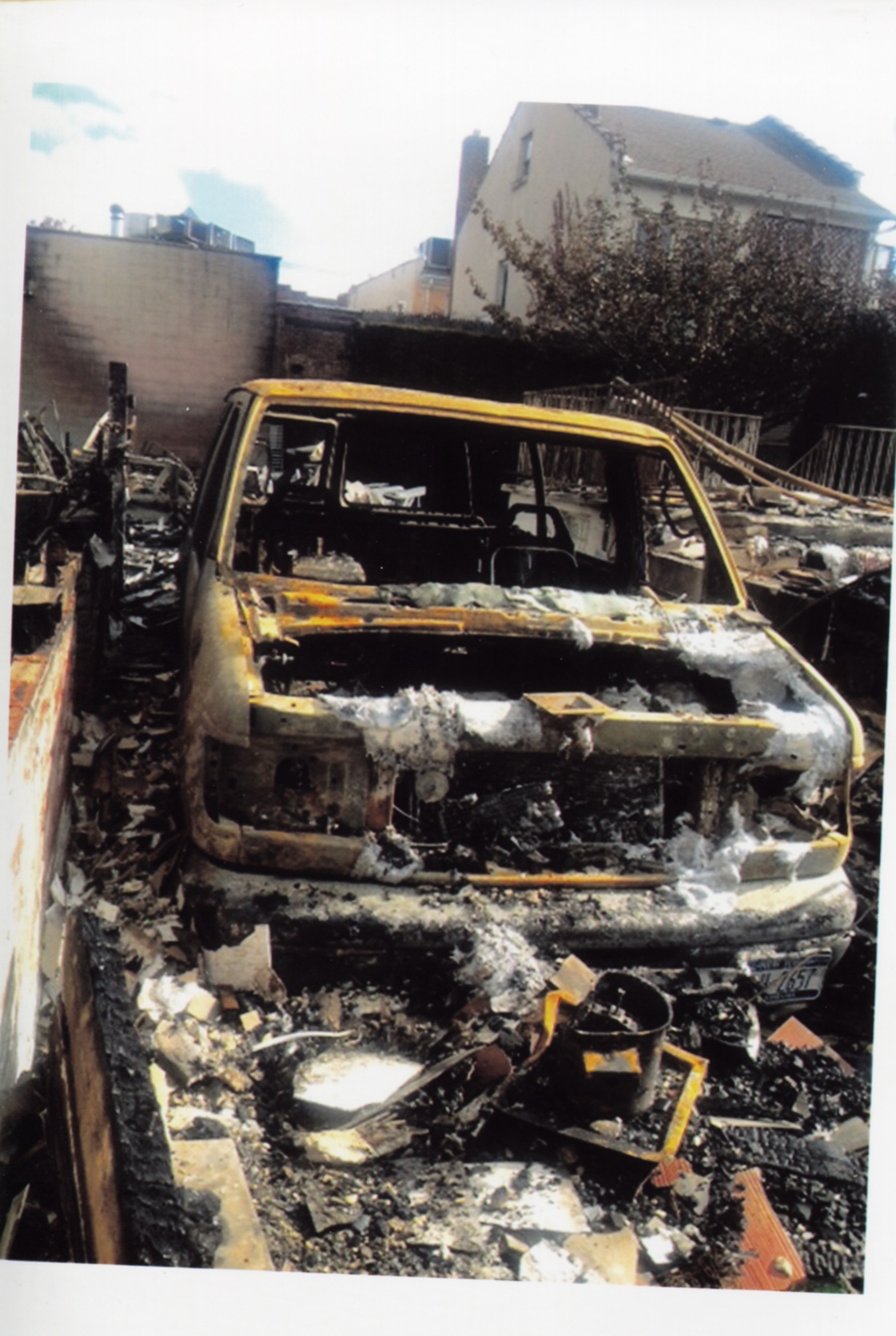
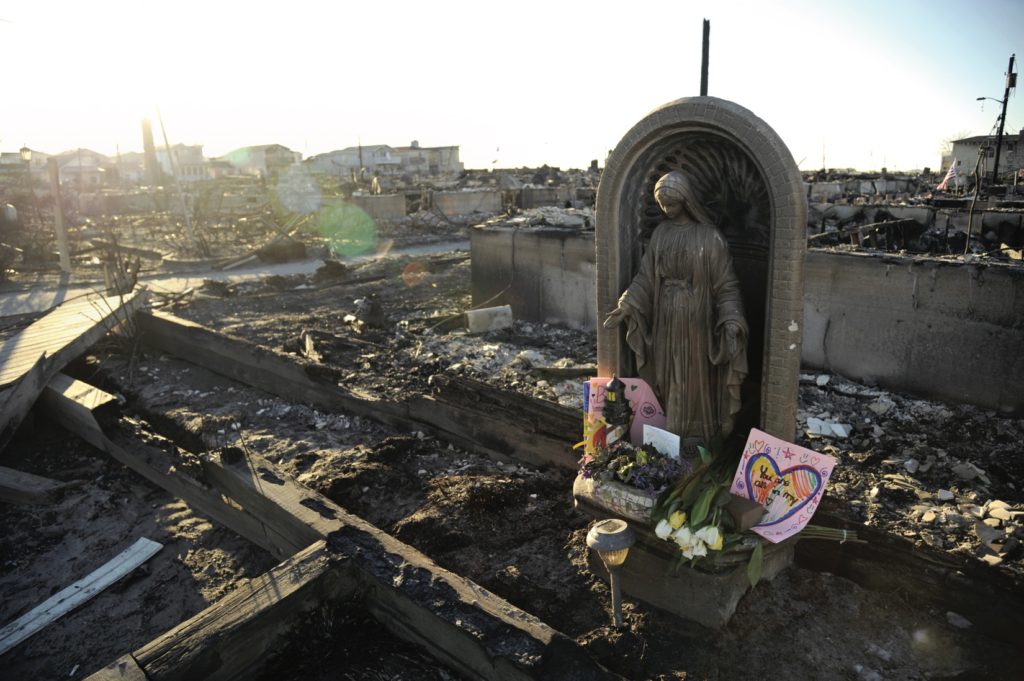
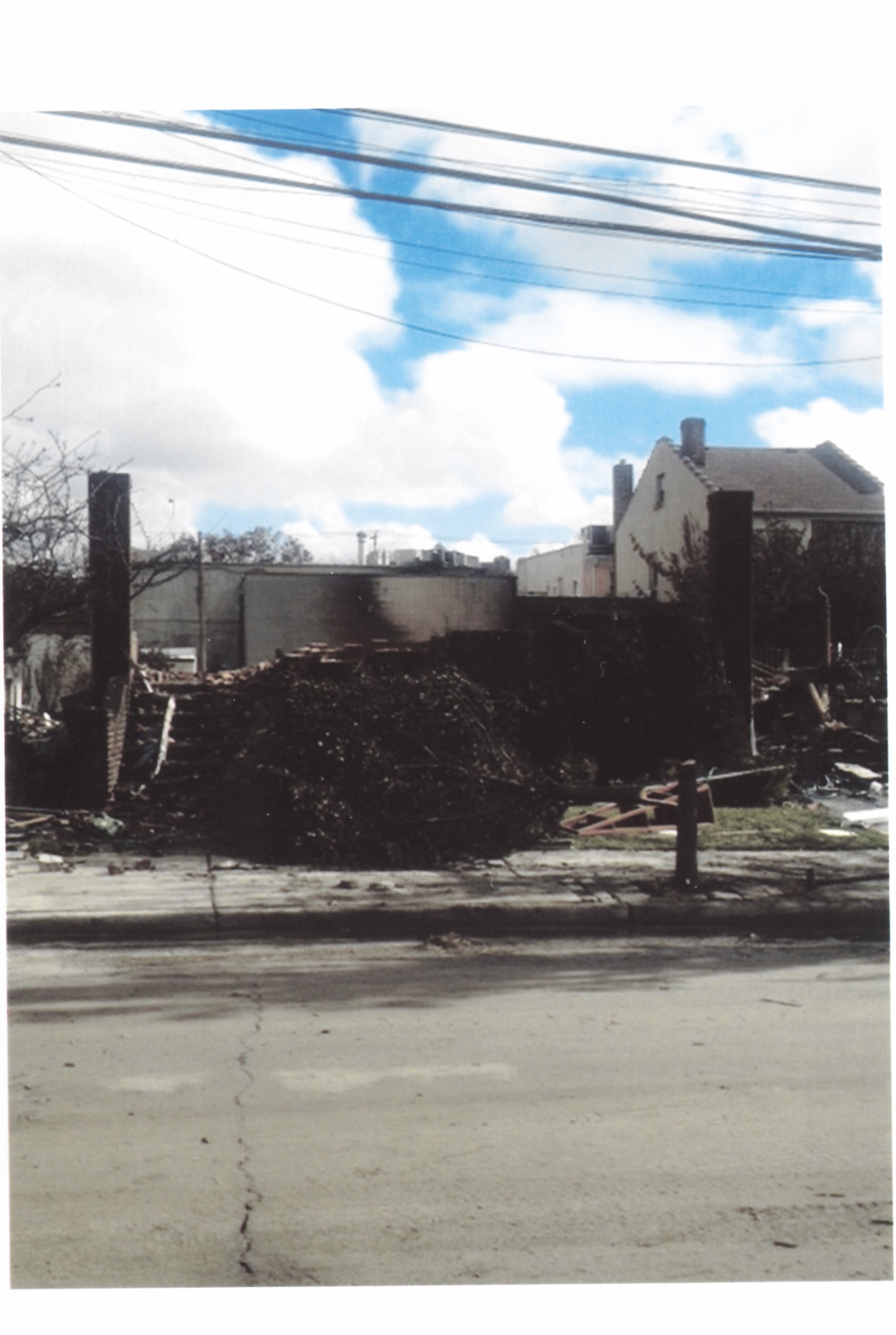
Top, far left: Ryan McDade’s photo of what’s left of the family van, and far-right, what’s left of his family home. Center: A statue of the Virgin Mary stands intact among the ruins in Breezy Point.
“I knew it, but I didn’t want to believe it,” said Ryan. “I didn’t know for sure until the next morning at five a.m.” All that was left of the only home he had ever known was ashes.
Throughout the night, 111 homes would burn to the ground, destroying an entire community.
The next day, as the waters subsided when the tide ran out, an uncle made it over the bridge and drove the McDades to his house in Rockville Centre on Long Island.
Xavier High School was in the part of Manhattan that was plunged into darkness, so school was canceled for a week.
With electricity out across much of the city and cell phones drained of power or missing entirely, it took football coach Chris Stevens until Saturday to check up on the whole team, and what he found was stunning. More than a quarter of his players – 11 kids out of the 43-person team – had been forced from their homes.
“When I heard McDade’s story, I just asked, ‘who’s going to play you in the movie?’” joked Coach Stevens.
Across Xavier High School, 80 of the 1,000-person student body were forced out of their homes.
“After a few days, my dad said, ‘Hey we can help out here,’” recalled Connor Sweet.
Said his dad, Kerry Sweet, “I’m an NYC cop and I had gone out to the Rockaways, and could not believe it.” The elder Sweet is a third-generation Irish-American, although he’s not sure exactly where his ancestors came from. “I’m named after a county, but I have no idea if that’s where we’re from.” Connor soon had four “brothers” move into his family’s Manhattan apartment: McDade, Kilgallen, Jimmy Wolfer, and Bryan Carley.
With subways still erratic, Connor Sweet and his “brothers” could walk to the school a few miles away when Xavier re-opened one week later. “It took a lot of pressure off us,” recalled Steve McDade, who was busy moving the rest of the family from his brother’s home on Long Island into a temporary apartment in Brooklyn.
The CHSFL canceled the junior varsity championship series for the season and began polling the varsity teams from the hardest-hit areas, asking them if they wanted to call off the season and cancel the playoffs. It would be an all-or-nothing call.
Coach Stevens asked the displaced kids if they wanted to continue the season. The vote was a unanimous yes. “Football was one of the few things we had that was normal,” said Ryan McDade. “We didn’t want to lose that too. We said we wanted to win the championship.”
“It wasn’t just a commitment by the kids, it was a commitment by the parents, who gave up a lot of youth muscle,” said Stevens, who when he is not coaching football is teaching history.
Their main practice field in Brooklyn was underwater, so Stevens had the kids practicing mostly indoors in the school gymnasium or the cafeteria, running plays while dodging support beams.
The single-elimination tournament had them facing off against top-seeded Mount St. Michael’s, which plays in the larger school division in the regular season.
With three weeks since their last game, the Knights looked sluggish and trailed 22 to 12 at halftime. For a while, it looked like it might be a repeat of the 2011 season, when a Xavier team that had gone undefeated in its league season was defeated in the first round of the playoffs by St. Joseph by the Sea from Staten Island.
Tre Solomon, the number one rusher in the city with 2,343 yards and number two scorer in the state with 29 rushing touchdowns, lives in Brooklyn and said it took him a few days before the enormity of Sandy’s tragedy sunk in. “When coach told me what happened to my teammates, I was heartbroken,” said Solomon, who in addition to his offensive prowess also had 63 tackles and was team MVP two years in a row. Trailing in a playoff football game seemed small in comparison with the adversity endured by his teammates. “I honestly had not looked at the scoreboard,” he said. “I thought we were still in it.”
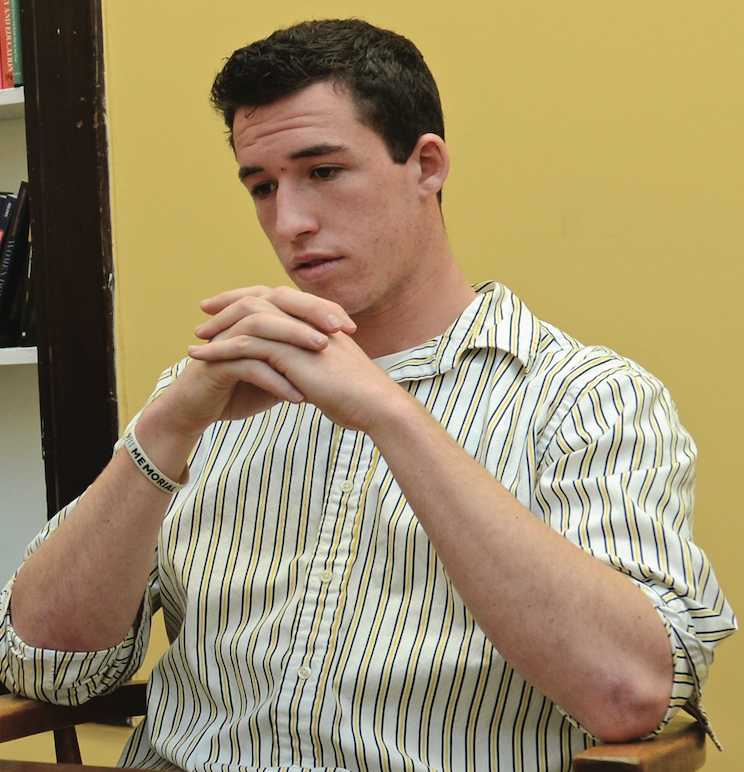
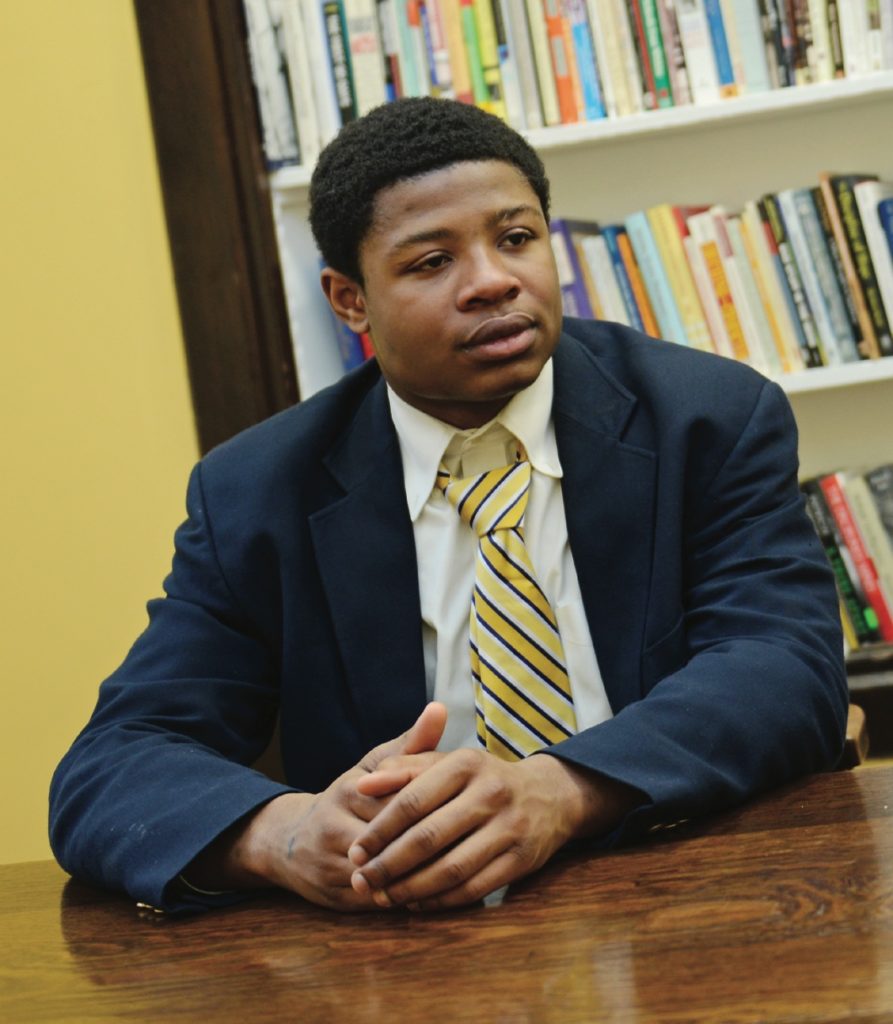
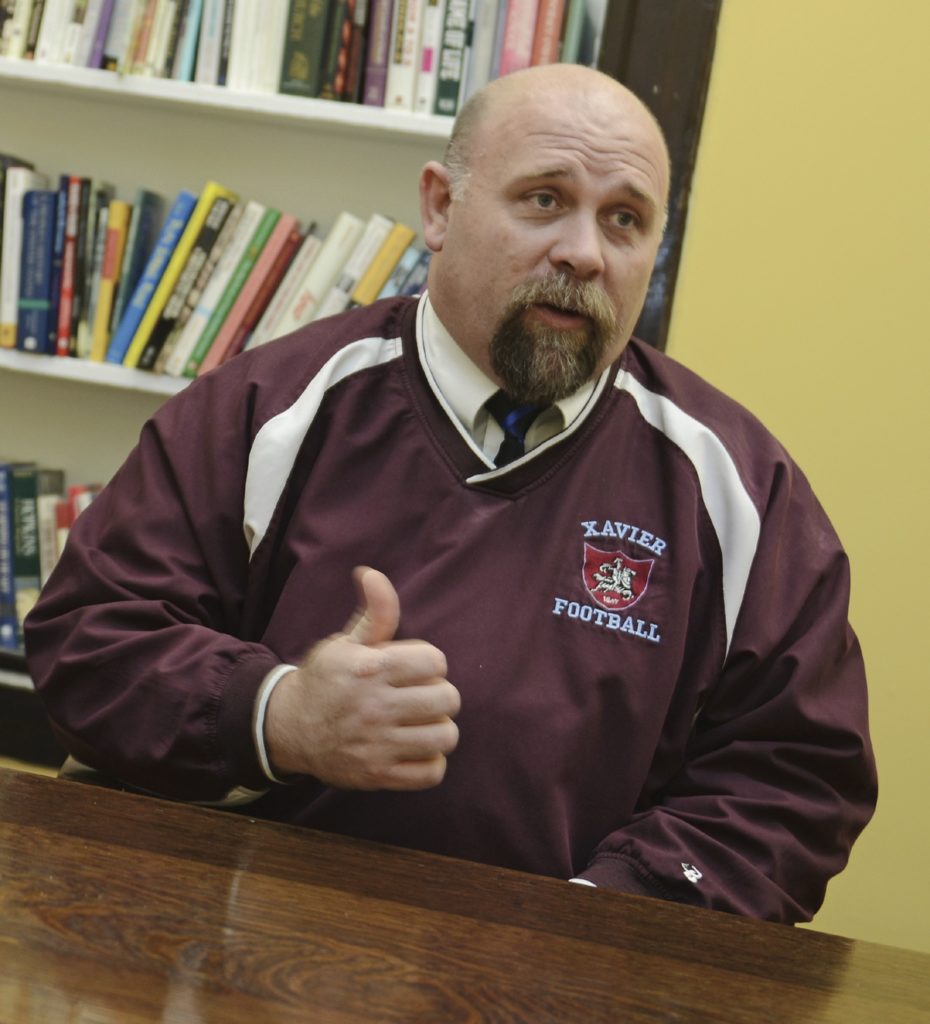
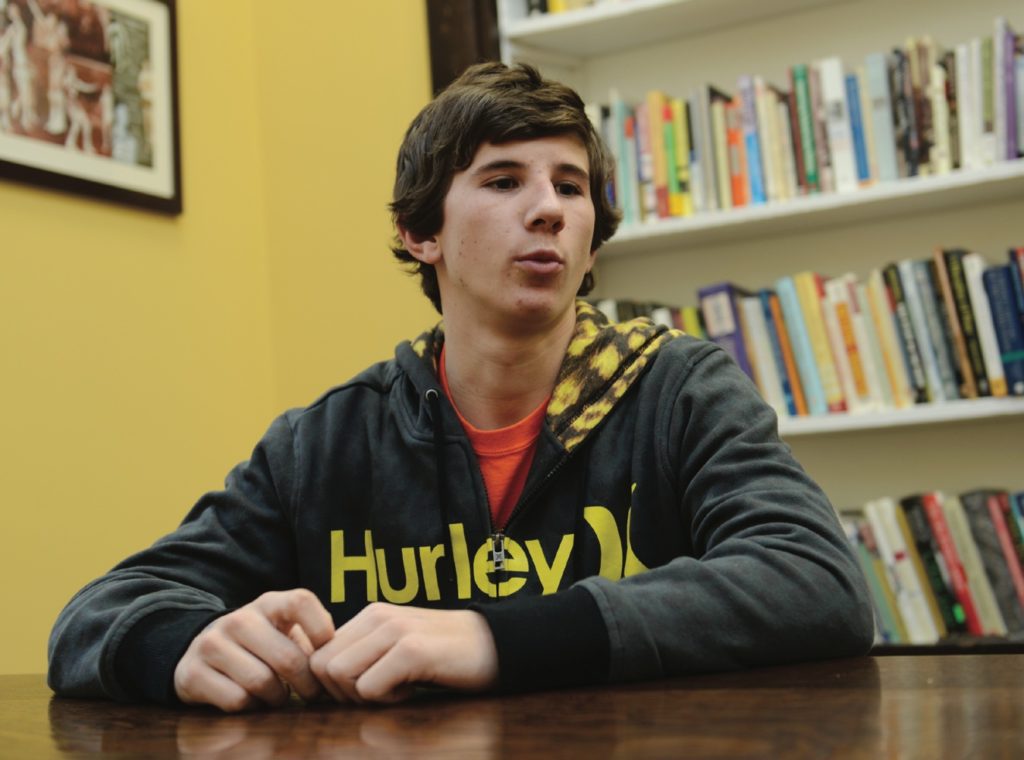
From left: Ryan Kilgallen, who traces family roots to Dublin, reflects on the championship season, William “Tre” Solomon said love for his teammates propelled him on his playoff run, Xavier football Coach Chris Stevens and Ryan McDade.
Xavier stopped the Mounties on the first drive of the second half and then scored on their next possession to pull within one. Momentum was heading their way again. “We made a couple of defensive stops and Wolfer came up with a big interception,” recalled Stevens. The Knights climbed back to a 25 to 22 lead and never looked back. They pushed it to 40 to 29 before the Mounties scored late in the fourth quarter to close the gap to 40 to 36. But that would be all. The Knights recovered the onside kick to end the game. Solomon had scored all six touchdowns.
Now they would take their ground-and-pound offense to square off against traditional rival Fordham Prep in their annual Thanksgiving showdown. The two Jesuit schools first clashed on the gridiron back in 1883, and USA Today recently voted the annual classic the best high school football rivalry in New York State. “Fordham is always tough and the Turkey Bowl is a game unto itself,” said Connor Sweet.
The game was being played in historic Rose Hill on the Fordham University campus, before 6,500 fans, and this year, aside from settling the annual Jesuit grudge match, it would determine who advanced to the CHSFL championship game in the AA division.
In the lead-up to the game, Coach Stevens had found a box of red hammers that some were using on the now weekly relief trips students and parents were running to Rockaway. At the pep rally, two red-handled hammers crossed into the shape of an “X” became the new unofficial school symbol.
For the next two games, the Xavier co-captains would carry a hammer to the coin toss. “It was a symbol of hope and rebuilding, but we still had to explain to the refs why our captains were carrying a hammer,” said Stevens.
Xavier scored first, but Fordham tied it up as they headed to halftime and then jumped out to a 14 to 7 lead early in the third quarter. Once again, the Knights were forced to dig deep for another second-half comeback, allowing only two Fordham TDs while scoring four TDs themselves in the half en route to a 38 to 21 victory. Solomon racked up 252 yards, Kilgallen had 98 yards rushing, and Connor Sweet chipped in with five unassisted tackles on defense.
The game was over and Xavier had a cherished victory in the Turkey Bowl. But for the football players, who realized that the Rockaways and Breezy Point would never be the same again, it also meant ten more treasured days of football season.
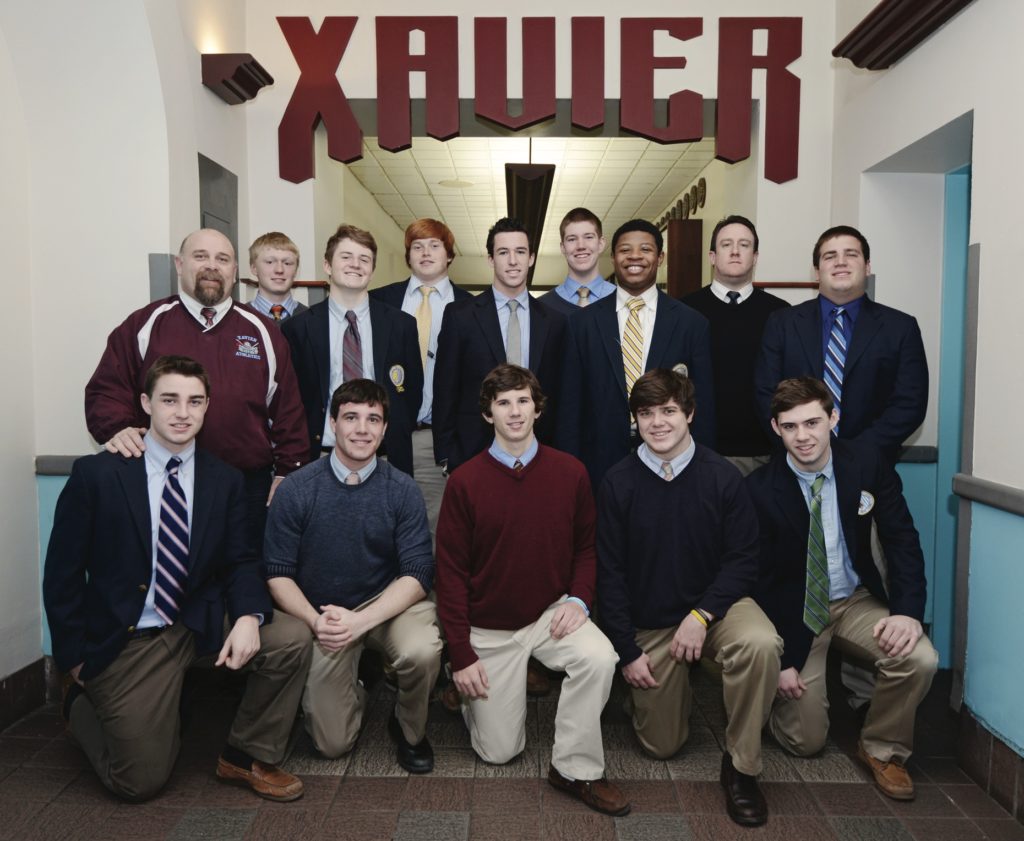
“We had talked about extending the season,” said Coach Stevens. “That was our goal – not necessarily to win the championship, but just to get to the championship so that we could extend the team camaraderie for ten more days, in support of our teammates who had been driven from their homes. Ten more days closer to normalcy. It was ten more days of positive distraction for the parents as well.”
That set up the final game with St. John the Baptist, a strong football school from West Islip, Long Island. The two teams had already clashed in the regular season, and St. John’s had shut out Xavier, 14 to 0. Most observers were pegging the Long Island school as the favorite.
Stevens figured St. John’s would be keying on Solomon, his 5’11” 200 lb. junior powerhouse. But it was Kilgallen who emerged as the offensive star of the game, racking up 100 yards rushing while Solomon grabbed two interceptions and Jimmy Wolfer added a third.
Xavier scored first for a 7 to 0 lead, but St. John’s battled back to tie it before Xavier pulled ahead to a 14 to 7 lead at halftime. The Knights cruised to an eventual 35 to 14 victory.
Coach Stevens works hard to keep it all in perspective. “I tell them this is just a moment in time,” he says, although its significance is not lost on a history teacher. He was the first to label their improbable road to victory “the feel-good story of Sandy.”
But sometimes it’s more than just a football game. There’s a coaching staff that includes defensive coordinator Kevin Kelly, offensive and defensive line coach Brian McMahon, receivers and linebackers coach Matt Furey and assistant line coach Dave O’Brien. All helped to rally the team behind the displaced eleven.
You can’t do a story on Breezy without the Irish element, but the Xavier football team was a lot more than that, everyone pulling as one to help fallen comrades.
“Football brought us back together,” said Ryan McDade. “It meant the world to us.”
Said Coach Stevens, “It was great to be able to give people who were struggling through some serious hardships a happy ending.”
As Kerry Sweet noted, “It was amazing how the kids bonded together. They were always close, but this was something different.
“It really wasn’t until they won against St. John’s that you realized how important it was to them. There were tears in a lot of their eyes. They bought into the whole thing. It was a once-in-a-lifetime memory. It’s something they’ll never forget.”

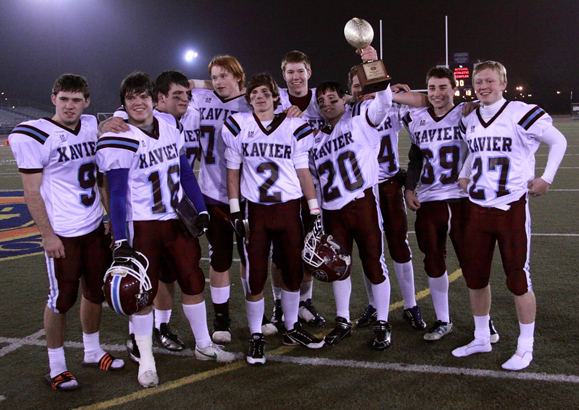
Loved your piece- also have a hard copy. No rush, but feel free to e-mail directly or through the New York Press Club. I feel this is an award-winning piece. I have a suggestion for ; again no rush.
Thanks,
Larry Seary
President
The New York Press Club